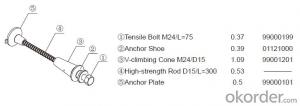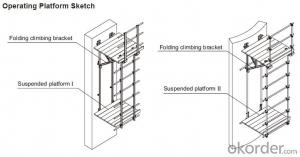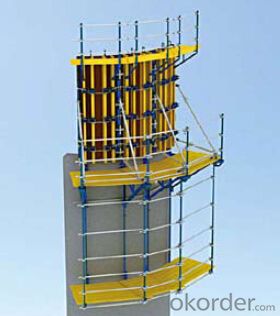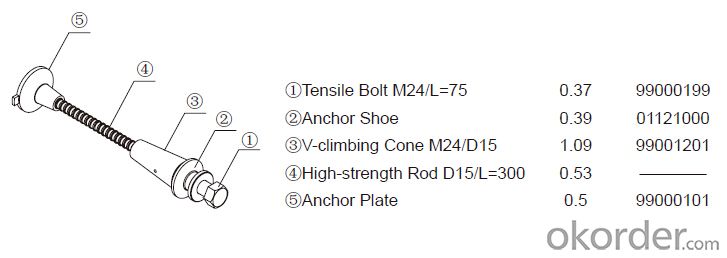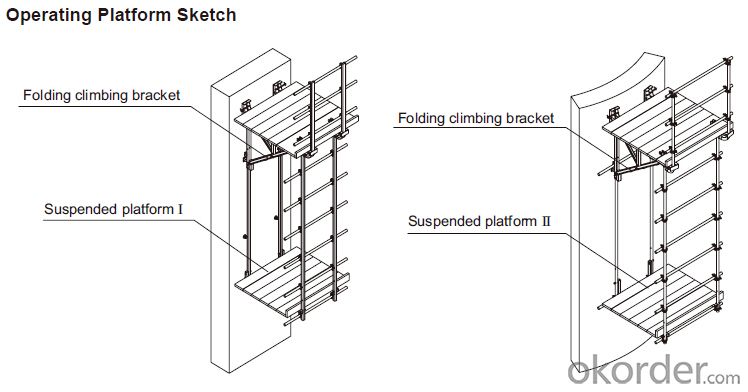Climbing-Platform CP190 for formwork and scaffolding system
- Loading Port:
- Tianjin
- Payment Terms:
- TT OR LC
- Min Order Qty:
- 50 m²
- Supply Capability:
- 1000 m²/month
OKorder Service Pledge
OKorder Financial Service
You Might Also Like
Climbing Platform CP190
Climbing bracket CP190 is mainly used as operating platform during construction. It can be used
on the vertical wall and arced wall. The bracket hang on the anchor system and all the load are
supported by anchor system. It’s convenient to assemble and dismantle, the construction is easy,
rapid and safe.
Anchor System:
Anchor system is the most important supporting part. The system is made of five parts shown
below. There into, tensile bolt, anchor shoe and V-climbing cone can be taken out for reusing.
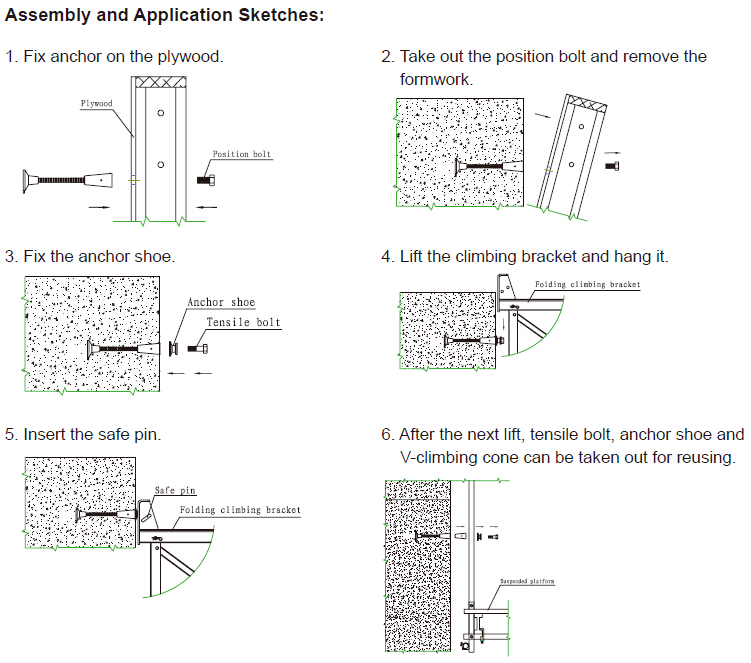
- Q: How does steel formwork handle concrete vibration during pouring?
- Steel formwork is designed to withstand the forces and pressures generated during concrete pouring and vibration. It provides a rigid and stable structure that can effectively handle the vibrations caused by the pouring process. The steel formwork is securely fixed in place, ensuring that it remains steady and does not deform or collapse under the impact of concrete vibration. Additionally, the steel material used in formwork construction has high strength and durability, allowing it to withstand the mechanical stress and vibrations induced by the pouring process without compromising its integrity.
- Q: Can steel formwork be used for curved structures?
- Curved structures can indeed make use of steel formwork. Steel is an incredibly versatile and robust material that can be easily manipulated and crafted into various shapes, including those with curves. By utilizing advanced technologies like computer-aided design (CAD) and computer-aided manufacturing (CAM), steel formwork can be specifically tailored to meet the precise needs of curved structures. This allows for increased flexibility and innovation in architectural design, empowering engineers and architects to fashion one-of-a-kind and visually captivating curved structures. Furthermore, steel formwork possesses numerous advantages such as longevity, reusability, and the ability to bear substantial loads. These qualities make it an ideal choice for constructing curved structures that necessitate both structural strength and stability.
- Q: How does steel formwork affect the overall material wastage in construction?
- Steel formwork can significantly reduce material wastage in construction. Unlike traditional timber formwork, steel formwork is reusable and durable, which means it can be used multiple times for different construction projects. This reduces the need for constantly buying and disposing of new formwork materials, resulting in less overall material wastage. Additionally, steel formwork provides better dimensional accuracy and stability, minimizing errors and the need for rework, further reducing material wastage.
- Q: What are the common design considerations for steel formwork in hot climates?
- When designing steel formwork for use in hot climates, there are several common considerations that need to be taken into account. 1. Thermal Expansion: Steel has a high coefficient of thermal expansion, meaning it expands and contracts with temperature changes. In hot climates, where temperatures can reach extreme levels, it is important to account for this expansion in the design of the formwork. Adequate expansion joints and allowances should be provided to accommodate the thermal movement of the steel. 2. Heat Resistance: Steel formwork should be designed to withstand high temperatures without significant deformation or loss of strength. This may involve selecting steel grades with higher heat resistance or employing additional cooling measures to prevent overheating. 3. Corrosion Protection: Hot and humid climates can accelerate the corrosion process, so it is important to incorporate effective corrosion protection measures into the design. This can be achieved through the use of corrosion-resistant coatings, such as galvanization or epoxy coatings, or by incorporating sacrificial anodes to protect the steel from corrosion. 4. Ventilation: Hot climates often require adequate ventilation to prevent the buildup of heat and moisture within the formwork. Properly designed openings and vents should be included to facilitate air circulation and prevent the formation of condensation, which can lead to corrosion and reduce the lifespan of the formwork. 5. Insulation: In extremely hot climates, insulation can help to reduce the transfer of heat to the formwork, minimizing the effect of thermal expansion and reducing the risk of deformation. Insulation materials, such as foam or reflective coatings, can be used to provide a barrier between the steel formwork and the external environment. 6. Durability: The design of steel formwork should take into consideration the long-term durability requirements of the project. This includes selecting materials and construction methods that are resistant to degradation from UV radiation, extreme temperatures, and other environmental factors commonly found in hot climates. Overall, designing steel formwork for use in hot climates requires careful consideration of thermal expansion, heat resistance, corrosion protection, ventilation, insulation, and durability. By addressing these factors, the formwork can withstand the challenges posed by hot climates and ensure the successful completion of construction projects.
- Q: Can steel formwork be used for precast concrete slabs?
- Yes, steel formwork can be used for precast concrete slabs. Steel formwork is a commonly used method for creating the molds or formwork for pouring concrete in precast construction. Steel formwork offers several advantages, including high durability, reusability, and superior strength compared to other types of formwork materials. It provides a rigid and stable structure that can withstand the weight and pressure of the concrete during the casting process. Steel formwork also allows for precise shaping and finishing of the concrete slabs, ensuring a high-quality and consistent end product. It can be easily assembled and disassembled, making it suitable for repetitive use in precast concrete production. Additionally, steel formwork can be designed and customized to meet specific project requirements, including different sizes, shapes, and patterns for the concrete slabs. However, it is important to consider the cost and maintenance of steel formwork, as it can be more expensive compared to other types of formwork materials such as wood or plastic. Regular maintenance and cleaning are necessary to ensure the longevity and efficiency of steel formwork. Overall, steel formwork is a reliable and widely used option for creating molds for precast concrete slabs, offering numerous benefits in terms of strength, durability, and customization options.
- Q: Can steel formwork be used for underground construction projects?
- Yes, steel formwork can be used for underground construction projects. Steel is a durable and strong material that can withstand the pressure and conditions found in underground structures. It provides stability and support during the construction process and can be easily reused or recycled after the project is completed.
- Q: What are the typical lifespan and durability of steel formwork systems?
- The durability and lifespan of steel formwork systems can vary depending on several factors, including the quality of the steel, maintenance practices, and intensity of usage. Steel formwork systems are generally known for their exceptional durability and long lifespan. When high-quality systems are properly maintained, they can last for several decades. These systems are designed to withstand heavy loads, repetitive use, and different weather conditions. To enhance their durability, protective measures like galvanization or coating are often applied to prevent corrosion. These measures significantly extend the lifespan by preventing rust and other forms of deterioration. However, it is important to consider that improper handling, inadequate maintenance, or exposure to harsh environments can affect the lifespan and durability of the systems. If the systems are not cleaned, stored, or maintained properly, their lifespan may be reduced. Furthermore, the intensity of usage can impact the lifespan of steel formwork systems. Heavy use or excessive stress can compromise their durability, resulting in a shorter lifespan. In conclusion, steel formwork systems are highly durable and have a long lifespan. With proper maintenance and care, high-quality systems can provide a reliable and cost-effective solution for concrete construction projects for several decades.
- Q: What are the different types of surface treatments available for steel formwork?
- Steel formwork offers a variety of surface treatments, each with its own unique benefits and characteristics. One option is galvanization, which involves applying a layer of zinc to the steel. This treatment protects against corrosion, extends durability, and provides a smoother surface finish. Another choice is powder coating, where a dry powder is applied and heated to create a protective layer. This treatment offers excellent resistance to corrosion, impacts, and chemicals, and comes in a wide range of colors. Painting is a common method where a layer of paint is applied for both aesthetics and protection against corrosion and environmental factors. Epoxy coating is another option, involving a layer of epoxy resin that provides resistance to corrosion, chemicals, and abrasion. It also offers easy cleaning and maintenance with its smooth finish. Shot blasting is a process of propelling steel shots onto the surface to remove rust, scale, or contaminants, resulting in a clean and roughened finish. This treatment also improves adhesion for subsequent surface treatments. Although typically used for aluminum formwork, anodizing can also be applied to steel. This treatment creates an oxide layer that enhances corrosion resistance and improves appearance. Overall, the choice of surface treatment for steel formwork depends on factors such as corrosion resistance, aesthetics, durability, and environmental conditions. It is important to consider these factors before selecting the most suitable treatment.
- Q: How does steel formwork compare to plywood formwork?
- Steel formwork is generally considered to be more durable and long-lasting compared to plywood formwork. Steel formwork can withstand higher levels of pressure, making it suitable for heavy-duty construction projects. Additionally, steel formwork offers greater dimensional accuracy and stability, resulting in fewer defects in the final concrete structure. While plywood formwork may be more cost-effective in certain scenarios, steel formwork is often preferred for its strength, durability, and ability to be reused multiple times, making it a more sustainable option in the long run.
- Q: Does steel formwork require any special expertise or training for installation?
- Yes, steel formwork generally requires special expertise or training for installation. The process involves understanding the structural requirements, proper handling and assembling of steel components, as well as ensuring the formwork's stability and safety. Expertise in steel construction and knowledge of formwork systems are usually necessary for a successful installation.
Send your message to us
Climbing-Platform CP190 for formwork and scaffolding system
- Loading Port:
- Tianjin
- Payment Terms:
- TT OR LC
- Min Order Qty:
- 50 m²
- Supply Capability:
- 1000 m²/month
OKorder Service Pledge
OKorder Financial Service
Similar products
Hot products
Hot Searches
Related keywords

